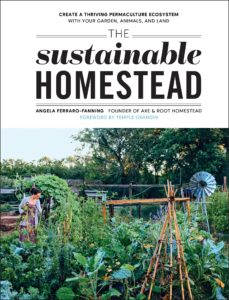Homesteading has become increasingly popular these past several years. People interested in being more self-sufficient and leading a simpler life have taken up growing their own food, tending livestock, and making homecrafts to use and sell.
It’s not just for those with 150 acres of land, five tractors, and 80 head of cattle, either. The agrarian lifestyle is attractive to those in urban settings with smaller outdoor areas, as well. It can be for you, too. Start off small and see where it takes you. Plant some fruit trees, raise chickens, consider solar options, pickle your own vegetables. Whether your goal is to live off the grid completely, or grow a bed of vegetables for a salsa garden (absolutely), the enhanced connection you’ll feel to the land will offer quite the reward.
 “The Tiny But Mighty Farm: Cultivating High Yields, Community, and Self-Sufficiency from a Home Farm” by Jill Ragan is full of guidance and inspiration for those ready to start producing their own food. From deciding what type of grower you want to be–a hobbyist, a homesteader, or a full-time farmer, to mapping out your garden and cost analysis, Ragan offers practical tips to get started. She shares different growing techniques and possible business opportunities, imparting the important message that cultivating also means connection and community. Check out her YouTube channel at Whispering Willow Farm.
“The Tiny But Mighty Farm: Cultivating High Yields, Community, and Self-Sufficiency from a Home Farm” by Jill Ragan is full of guidance and inspiration for those ready to start producing their own food. From deciding what type of grower you want to be–a hobbyist, a homesteader, or a full-time farmer, to mapping out your garden and cost analysis, Ragan offers practical tips to get started. She shares different growing techniques and possible business opportunities, imparting the important message that cultivating also means connection and community. Check out her YouTube channel at Whispering Willow Farm.
 In “The Seven-Step Homestead: A Guide for Creating the Backyard Microfarm of Your Dreams,” Leah M. Webb starts off small, showing you how to prep, plant, and tend a couple of 4 x 8 foot garden beds. As you advance through the book, the growing space for the homestead gradually gets larger and the diversity of plantings include trees, shrubs, and storage crops, like potatoes and beans. Also included is a chapter on raising chickens, their care, food, and types of enclosures.
In “The Seven-Step Homestead: A Guide for Creating the Backyard Microfarm of Your Dreams,” Leah M. Webb starts off small, showing you how to prep, plant, and tend a couple of 4 x 8 foot garden beds. As you advance through the book, the growing space for the homestead gradually gets larger and the diversity of plantings include trees, shrubs, and storage crops, like potatoes and beans. Also included is a chapter on raising chickens, their care, food, and types of enclosures.
 “The Sustainable Homestead: Create a Thriving Permaculture Ecosystem with Your Garden, Animals, and Land” by Angela Ferraro-Fanning has all the important information you’ll need to run a full-fledged homestead. Not only does she include information on soil health, planting, and sample layouts for different sized homesteads, but expands to incorporate information on animals and orchards. All of her animals, in addition to being super cute, are contributors to the farm, as well. The horses provide manure for compost and pull carts. The ducks provide eggs and control the insect population. Her chapter on designing a pasture covers the many considerations that you’ll need to address, like grazing and pasture rotation, when keeping livestock.
“The Sustainable Homestead: Create a Thriving Permaculture Ecosystem with Your Garden, Animals, and Land” by Angela Ferraro-Fanning has all the important information you’ll need to run a full-fledged homestead. Not only does she include information on soil health, planting, and sample layouts for different sized homesteads, but expands to incorporate information on animals and orchards. All of her animals, in addition to being super cute, are contributors to the farm, as well. The horses provide manure for compost and pull carts. The ducks provide eggs and control the insect population. Her chapter on designing a pasture covers the many considerations that you’ll need to address, like grazing and pasture rotation, when keeping livestock.
Both my great-grandfather, Benjamin Franklin Maxson Sr., (1841-1899) and grandfather, Benjamin Franklin Maxson Jr., (1879-1928) were pioneers in the walnut farming industry in the El Monte and West Covina areas. Along with other local growers, my grandfather founded the La Puente Valley Walnut Growers’ Association in 1912 and was its original member until his death. I inherited a bit of that growing passion too and enjoy tending a small grove of olive trees in my backyard.